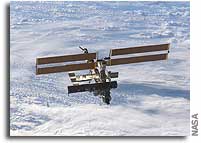NASA Space Station On-Orbit Status 31 Jul 2003

All ISS systems continue to function nominally, except as noted previously or below. Day 98 in space for the Increment 7 crew.
At about 6:45am EDT, the crew set up and initiated today’s scheduled Robotics/SSRMS (space station remote manipulator system) operations. All objectives were successfully accomplished. [Purpose of the ops was to provide the crew with some proficiency time with the MSS (mobile service system). Also, the ground wanted to use the activities as an opportunity to satisfy some external viewing objectives. The arm was based on MBS PDGF 1 (mobile base system power and data grapple fixture #1), and started out at the PDGF 3 pre-grapple position, then grappled the PDGF, followed by immediate release and back-out to the 5 ft. start position. Then, the SSRMS was maneuvered in single-joint mode to a position where the Tip LEE (latching end effector) and Tip Elbow cameras could see an “H-fixture” on the zenith side of the S1 truss and maneuvered the Tip LEE camera in closer to that H-fixture for video taping. The final arm maneuver of the day was done with a Joint OCAS (operator commanded auto sequence) which placed the arm in a position to get another external viewing objective: to take a look at one of the SVS (space vision system) targets on the S1 truss.]
Later in the day, Ed Lu will again de-install the utility outlet panel (UOP)-to-display & control panel (DCP) power bypass cable of the MSS.
CDR Yuri Malenchenko conducted another experiment session with the Russian/German Plasma Crystal-3 (PK-3) payload, activating the evacuation turbopump, tagging up with ground specialists and starting the evacuation of the vacuum chamber (ZB) and PK-3 operations. [The experiment is performed on plasma, i.e., fine particles charged and excited by RF/radio frequency power inside the evacuated work chamber. Today, Yuri monitored the investigation of the behavior of large particles (from Dispenser B), in two parts, viz., auto search for conditions promoting strong particle agglomeration (6 min.), and auto search for conditions creating “void-free” structures while varying HF discharge energy, chamber pressure, and number of particles involved (75 min.).]
In the DC-1 docking compartment, Malenchenko replaced a ROM (read-only memory) memory unit (PZU/TA765B) in a local signal commutator (LKT 1GZ) behind panel 401.
Yuri also performed his regular daily inspection of the BIO-5 Rasteniya-2 (“Plants-2”) experiment which researches growth and development of plants under spaceflight conditions in the Lada-2 greenhouse. Later, he transferred the accumulated data files to a floppy disk for storage, and took digital photos of the plants. [The experimental seeds of two types of peas (a flagellate variety with reds flowers, up to 27 cm high, and an acacia-leaf variety with white flowers, up to 20 cm high) are planted between wicks in a root tray, with environmental control powered on. Regular daily maintenance of the experiment involves monitoring of seedling growth, humidity measurements, moistening of the substrate if necessary, and photo/video recording.]
FE/SO Ed Lu downloaded accumulated IWIS (internal wireless instrumentation system) data to SSC (station support computer) for downlink to the ground via OCA/S-band. He then was scheduled to replace the IWIS batteries throughout the ISS. [IWIS uses radio-linked accelerometers (RSUs, remote sensor units) in SM, Lab and Node to take structural dynamics (vibratory) measurements.]
The CDR attended to the daily routine maintenance of the SM’s SOZh environment control & life support system as well as the daily preparation of the IMS “delta” file.
At 2:50pm EDT, carried live on NASA TV, the ISS crew will engage in an interactive conversation with 25 teachers and administrators from five NASA Explorer Schools at NASA Ames Research Center. [The educators are participating in a five-day workshop focusing on how NASA can work with institutions to develop unique and compelling material to use in the classroom. The five participating schools are Chapman School, Sheridan, Ore.; Chiefess Kamakahelei Middle School, Lihue, Hawaii; Jim Bridger Middle School, Las Vegas; Poplar Middle School, Poplar, Mont.; and Waimea Middle School, Kamuela, Hawaii. They are among the 50 middle schools selected in the Explorer School program’s pilot year. The goal of the program is to address the nation’s needs in mathematics, science and technology for grades four through nine. During a three-year partnership, NASA will work with each school to incorporate the agency’s cutting-edge research and unique missions to inspire students. The program is sponsored and implemented by NASA through a cooperative agreement with the NSTA (National Science Teachers Association), Arlington, Va.]
Today’s CEO (crew earth observation) targets, limited in the current XPOP attitude by flight rule constraints on the use of the Lab nadir/science window, and including the targets of the Lewis & Clark 200-year memorial locations, were La Paz (looking a touch left for this major city which lies on the eastern rim of the high Andean desert. It is easy to miss those parts of the city at lower elevations in the canyons on the east side where warmer average temperatures raise residential land prices), Chongqing, China (this major city lies in the Red Basin just left of track on the Chiang Jiang. Obliques might show air pollution in this completely enclosed topographic basin), Toshka Lakes, Egypt (nadir view of this massive desert project), Egypt – Valley of the Kings (looking in the broken hill country immediately west of the Nile valley. The site lay a touch left of track), Statue of Zeus at Olympia (looking left of track), Athens, Greece (looking nadir and a touch left), Istanbul, Turkey (looking a touch left on both sides of the Bosporus strait), and Puerto Rico (interest lies in urban sprawl along the coasts, as well as in the coral reefs and their health, especially in the vicinity of the expanding urban areas. Mapping swaths are suggested).
CEO images can be viewed at the websites
See also the website “Space Station Challenge” at
http://voyager.cet.edu/iss/








